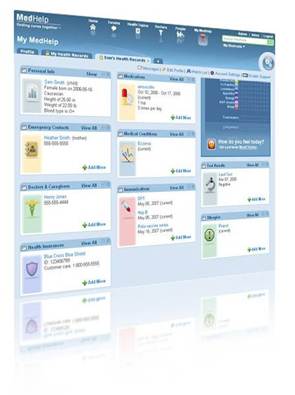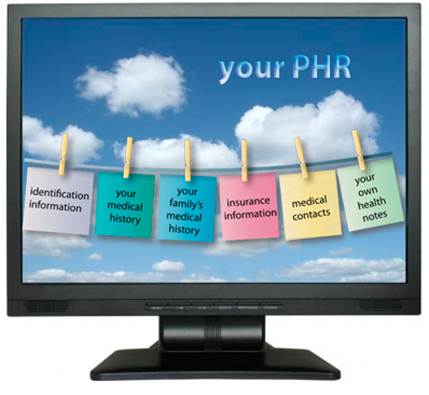Are your family’s files a total mess? Go paperless. Our guide
will simplify the process.

Organize Your
Health Records
Moms wear many medical hats. We nurse colds and fevers,
bandage scraped knees, kiss boo-boos, and treat ear infections, strep throats,
and stomach bugs. We’re also expected to keep tabs on everyone’s medications,
height and weight, allergies, and doctor visits. It’s a huge undertaking, which
is why your current record-keeping system probably looks something like this: a
manila folder bulging with scribbled doctor notes, insurance statements, copay
receipts, and appointment reminders. Worse, the really important stuff – like your
child’s immunization records – may be out of date or missing.
But there’s an easy-to-implement solution: personal health
records (PHRs). These Web-based tools allow you to collect and track health
information via your computer, smartphone, or tablet. You can also grant
partial or full access to others, which is helpful if you and your partner (or
a grandparent) switch off on your kids’ wellness visits. “Having the ability to
call up your family’s medical information anytime, anywhere makes health care
safer and more efficient,” says Mark Del Beccaro, M.D., chair of the American
Academy of Pediatrics’ council on clinical information technology.
PHRs combine records from doctors, labs, hospitals, and
pharmacies with your own notes, observations, questions, and wellness goals.
Got a child who’s under the weather? With a few finger taps, you can track
changes in her temperature, symptoms, sleep patterns, and meds and then call up
or print out the data to share with her pediatrician. In an emergency, it’s
easy to blank on the simple stuff (such as the name of an antibiotic your child
is allergic to), but a PHR eliminates the panic. It’s especially useful if you
or your child needs care when you’re traveling or if your area experiences a
natural disaster. “If your area loses power, your doctor may not be available
to provide the date of your child’s last tetanus shot or the names of drugs
he’s prescribed,” says Glen Stream, M.D., chairman of the board of the American
Association of Family Physicians. “But with a PHR, you’ll be all set.”

“If your area
loses power, your doctor may not be able to provide the date of your child’s
last tetanus shot or the drugs he’s prescribed. But with a personal health
record (PHR), you’ll be all set.”
Although gathering all the necessary data to compile your
family’s PHR takes time, you don’t need to tackle it all at once. Instead, try
working on a different person’s records each month. Once everyone’s info is
current and complete, updating it will be a snap.
Step 1: choose a platform
Web-based systems are the best way to go for instant data
access. The two leading PHRs, Microsoft HealthVault and WebMD Health Manager
(both are free), have the capability to link with most hospitals, doctors’
offices, labs, and pharmacies. Using your health plan’s PHR can be a time-saver
because key information (such as the date of last appointment and new
prescriptions) is automatically added. However, you can’t transfer the data if
the insurance provider changes. You can find a list of PHRs at myPHR .com.
Before choosing one, read the company’s privacy policy to make sure that it encrypts
personal data, cautions Dr. Stream. Even then you need to be careful; these
systems are as vulnerable to hacking as online bank and credit-card accounts.
Since PHRs may contain confidential information, including your family’s Social
Security numbers (some insurers still use them for identification purposes) ,
home address, and sensitive medical diagnoses, it’s important to use a
difficult-to-guess user name and password and avoid sharing it.
Step 2: gather medical records
You’ll need to collect and type in or scan the past two
years of medical information for you, your partner, and your children. “You
should go back farther for immunization records or if someone has a chronic
condition that has required a lot of testing, medications, or hospitalizations,”
recommends Lou Ann Wiedemann, director of professional-practice resources for
the nonprofit American Health Information Management Association. You have the
right to obtain virtually all of your and your kids’ health information within
30 days, thanks to the Health Insurance Portability and Accountability Act. However,
there are some exceptions to this rule, so be sure to check with a
health-information-management professional or your provider.
Begin the process by submitting medical-record release forms
to your primary-care physicians, pediatrician, ob-gyn, dentist, specialists,
and hospitals you’ve been treated at. Many medical offices post these forms
online. Otherwise, draft a letter asking to have them mailed or faxed to you
(find a sample at privacyrights.org). A doctor cannot deny you a copy of your
medical records, even if you haven’t paid for the services rendered. However,
he is allowed to charge you reasonable costs for copying and mailing the
records (some physicians may choose to provide this service for free). If the
doctor has an electronic health record, the patient must still provide
authorization prior to the sharing of information. “Because of security
concerns and personal-health-information laws, many doctors won’t e-mail
records,” says Marie Savard, M.D., coauthor of How to Save Your Own Life: The
Eight Steps Only You Can Take to Manage and Control Your Health. Make sure you
receive this key information for each family member:
·
Dates of immunizations
·
Blood typing
·
Lab results, such as cholesterol and blood-pressure readings, Pap
smears, and mammograms
·
Results of recent checkups, including height, weight, and body
mass index (BMI), also include children’s growth-chart percentiles.
·
List of chronic health conditions (such as asthma, ADHD, and
diabetes), including treatments, prescription names, and dosages
·
Allergies and sensitivities to medications, foods, and materials
·
History of hospitalizations (which the hospital’s medical-records
department can provide)
Step 3: compile personal info
Each family member’s PHR should also include:
·
Name, birth date, and contact information (address, e-mail, and
home- and cell-phone numbers)
·
Emergency-contact information
·
Phone numbers for the primary-care physician, dentist, eye
doctor, and any other specialists
·
Insurance information, including the member ID, group number,
copay amount, primary-care physician’s phone number and address, and contact
information for the healthcare provider
·
Daily medications (both prescription and OTC) and supplements, including
dosages, frequency, and reason for taking
·
Family history of physical and mental-health conditions. Include
parent and sibling information as well as close relatives with notable,
inheritable illnesses (i.e., an aunt who had breast cancer).
·
Summaries and links to critical health documents for adults, such
as living wills, medical power-of-attorney forms, and organ-donor
authorizations

Compile personal
info
Step 4: update regularly
An outdated PHR is of no use to you or your doctor, so set
aside a few minutes to input new data after each appointment. Ask the office to
send results and any notes directly to your PHR (if it has the capability) or
your e-mail. That way, you’ll always have the key elements of your family’s
medical history accessible, and your kids will have an excellent head start
when they take charge of their own health-care records.
A key id for your wallet
Even if you have a PHR, you and your spouse should carry
medical ID cards – which list emergency-contact information, the primary
doctor’s name and number, and medical conditions – for every family member.
Create your own at parents.com/medical-card. Don’t forget to update it whenever
any information changes.